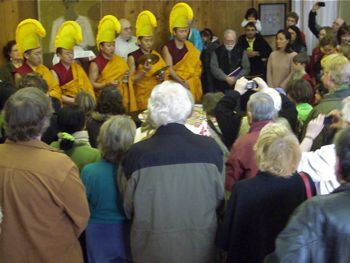The Association of Grandparents of Indian Immigrants (AGII) is a nonprofit that is “dedicated to the production of audiovisual materials for the families of Indian Immigrants.” Not only is AGII an interesting example of an attempt at identity formation for non-white families; not only does AGII draw on a faith tradition for identity formation; they also offer some excellent online text-based stories on the Indian and Hindu tradition: Kidz Korner: Stories from Indian Mythology.
Category: Art and religion
Creativity and maintenance
Finally, after years of cudgeling my brains, I’ve managed to track down a quote by Gary Snyder on the relationship between creativity and maintenance. It comes from a 1973 interview, which was then reprinted in Lookout: A Selection of Writings:
I like to sharpen my chain saw. I like to keep all my knives sharp. I like to change the oil in my truck.
Creativity and maintenance go hand in hand. And in a mature ecosystem as much energy goes to maintenance as goes to creativity. Maturity, sanity, and diversity go together, and with that goes stability. I would wish that we could in time emerge from traumatized social situations and have six or seven hundred years of relative stability and peace. Then look at the kind of poetry we could write! Creativity is not at its best when it’s a by-product of turbulence.
The concept in this quote, as you can see, could be applied to the current state of the U.S. economy, or to the adoption of new media by creative persons and by religious groups. But I think I’m going to use the concept in this quote for tomorrow’s sermon on spirituality and work.
Happy birthday, or, Vanitas
This gravestone, commemorating John Safford who died in 1782, stands in the old burying ground off the town common in Harvard, Massachusetts. The poetry at the bottom is two verses from Isaac Watts’s metrical version of Psalm 39:3, part three. As rendered by the gravestone carver, it reads as follows:
Crush’d as a moth beneath thy hands
We moulder to the dust;
Our feeble pou’rs can ne’er withstand
And all our beuty’s lost.
This mortal life decays apace
How soon the bubble’s broke
Adam and all his numerous Race
Are vanity and smoke.
Tibetan Monks, closing ceremony
The Tibetan Buddhist monks spent their final morning at the Palo Alto church. In addition to completing the sand mandala, they chanted for ten minutes in each worship service. As beautiful as the sand mandala was, I enjoyed the chanting the most: something about the low notes they managed to produce with their throat-singing, or more properly overtone singing, really got to me.
And of course they destroyed the sand mandala in a closing ceremony. They chanted for a good twenty minutes, and then one of them walked around the table and then drew his hand radially out from the center across the design in each quadrant and then again between each of those places. Then another monk came and swept the sand into the center; he used an ordinary four inch paint brush, which I thought was a nice touch; the best religious ceremonies mix the sublime with the ordinary.

The closing ceremony, just before the monks destroyed the mandala.
After the ceremony was over, I was talking with someone who said that twenty minutes of their chanting was plenty for her; but I said I disagreed, and could easily have listened for another hour.
Tibetan monks, day 3
Another picture of the monks working; the monk closest to the camera is incising a design into a background using a stylus (the point of a compass, actually); the monk at rear is adding a line of sand to the incised design:

At the end of the day today, the mandala was nearly complete:
It is hard to see in this photo, but the mandala is not a two-dimensional work; the sand is built up in low relief that is difficult to capture in a photograph.
Tibetan monks, day 2
Another photo of the Tibetan Buddhist monks working on the sand mandala. This was taken a quarter of an hour before they stopped working for the day.

A musical setting of KJV prose
This is the four hundredth anniversary of the King James Version translation of the Bible (KJV). As one way of honoring this monument of English prose literature, I’ve been composing some a capella four-part musical settings for short excerpts of the KJV. These settings are in the idiom of American singing-school music, an unbroken tradition of composition and performance going back to about 1720, and carried on today by Sacred Harp singers.
So here’s a song for Advent. The text is Mark 1.2-3; although Isaiah 40 might seem to make more sense as a text for Advent, the prose in the KJV translation of Mark 1.2-3 was just too perfect to pass up, and preachers are wont to use bits of Mark 1 as texts during Advent (for churches that use the lectionary, Mark 1.1-8 is the gospel reading for the second Sunday in advent in lectionary year B). As is traditional in this musical idiom, the song is named after a geographical place.
If you know anything about composition, this breaks many standard rules, but it is consistent with the Sacred Harp idiom.


